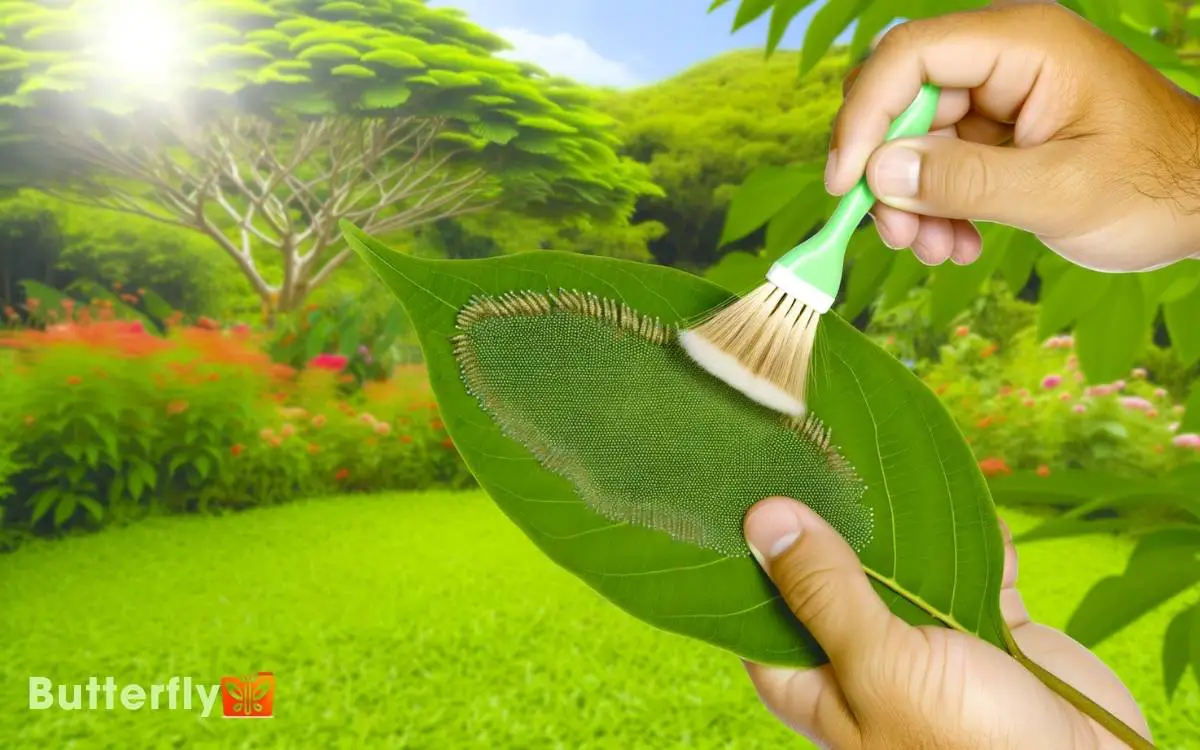How To Get Rid Of Butterfly Eggs On Plants? Methods!
To remove butterfly eggs from plants, start by inspecting leaf undersides using a magnifying glass to spot the eggs’ intricate patterns. Manually detach them with fine-tipped tweezers, ensuring you gently dislodge them to avoid damaging the plants.
Utilize high-pressure water sprays to wash off residual eggs, reducing larval infestation risks. Introducing natural predators like ladybugs and predatory wasps can also help control the egg population. Implement row covers to prevent butterflies from laying more eggs.
Regular monitoring and integrating companion plants can further bolster your pest management strategy. There are additional, refined techniques that can enhance your approach.

Key Takeaways
Identify Butterfly Eggs
To identify butterfly eggs, closely examine the undersides of leaves for tiny, spherical or oblong structures that vary in color depending on the species.
Use a magnifying glass to observe the intricate patterns and textures, vital for accurate identification. Different butterfly species lay eggs with specific characteristics; for instance, Monarch eggs are cream-colored and oval, while Swallowtail eggs are greenish and spherical.
Utilize a dichotomous key to differentiate between species. This methodical approach will guarantee you’re not mistaking other insect eggs for butterfly eggs.
Document your findings with high-resolution photographs, assisting in future identifications. By mastering these techniques, you’ll enhance your ability to monitor and manage butterfly populations innovatively, safeguarding your plants remain unaffected by larval feeding.
Inspect Your Plants
Consistently inspecting your plants guarantees early detection of butterfly eggs, allowing for timely intervention and effective management.
Focus on both the adaxial (upper) and abaxial (lower) surfaces of leaves, where eggs are often deposited. Utilize a magnifying glass or a digital microscope to enhance visibility, ensuring no ovipositional sites are overlooked.
Monitor your plants during peak oviposition periods, typically in late spring and summer. Document your findings meticulously, noting egg clusters and their developmental stages.
By integrating these inspections into your routine horticultural practices, you can implement biological or mechanical control strategies precisely when needed.
This proactive approach minimizes infestation risks, maintaining plant health and promoting sustainable, innovative gardening techniques.
Manual Egg Removal
Having meticulously inspected your plants, you can now proceed with manual egg removal to prevent larvae from hatching and causing damage. Equip yourself with fine-tipped tweezers or a soft brush for precision.
Gently dislodge the eggs typically found on the underside of leaves by lifting them away from the plant surface. Guarantee minimal contact with the plant tissue to avoid inadvertent injury. Dispose of the removed eggs in a sealed bag to prevent re-infestation.
For best results, repeat this process bi-weekly, as butterfly oviposition can be recurrent. Employing a systematic removal approach not only preserves plant health but also aligns with environmentally conscious pest management practices.
Use Water Spray
When manual removal isn’t sufficient, employing a targeted water spray can effectively dislodge butterfly eggs from plant surfaces. Utilize a high-pressure nozzle to generate a precise, forceful stream of water, aiming directly at the eggs. Be sure to inspect the undersides of leaves, as eggs are often hidden in less visible areas. Repeating this process every few days can help ensure that newly laid eggs are also removed before they hatch. If you’re also searching for information on how to remove butterfly earrings, consider gently unclasping them and using a soft cloth to avoid damage.
This method leverages hydraulic force to detach eggs without damaging the plant’s delicate tissues. Confirm the water pressure is robust enough to dislodge the eggs but not so intense that it harms the foliage.
Incorporate a systematic approach: begin spraying from the top of the plant and work your way down, ensuring thorough coverage. This technique not only removes visible eggs but also addresses those hidden beneath leaves.
Regular application can maintain plant health by preventing larval infestation, an innovative, eco-friendly alternative to chemical treatments.
Introduce Natural Predators
Another effective method to control butterfly eggs on plants is to introduce natural predators that specifically target and consume these eggs.
Ladybugs (Coccinellidae), green lacewings (Chrysopidae), and predatory wasps (Trichogramma) are excellent biological control agents.
These insects exhibit a high predation rate on lepidopteran eggs, disrupting the lifecycle of harmful butterflies without damaging your plants.
You’ll need to release these predators in sufficient quantities to guarantee effective control. Regularly monitor the predator population and the incidence of butterfly eggs to evaluate the efficacy.
This method leverages the principles of integrated pest management (IPM), providing a sustainable, eco-friendly solution that reduces reliance on chemical interventions. It’s an innovative approach that aligns with modern ecological gardening practices.
Apply Neem Oil
Neem oil, derived from the seeds of the Azadirachta indica tree, acts as a potent botanical insecticide to disrupt the growth and development of butterfly eggs on plants.
To apply, mix 1-2 tablespoons of cold-pressed neem oil with a gallon of water and a few drops of biodegradable dish soap to emulsify the solution. Spray this mixture directly onto the affected foliage, ensuring thorough coverage.
Neem oil contains azadirachtin, a compound that interferes with hormonal systems of insects, inhibiting feeding and reproduction.
For best results, apply in the early morning or late evening to minimize photodegradation. Regular application every 7-14 days will provide continuous protection.
This method is eco-friendly and integrates seamlessly into an innovative pest management strategy.
Use Insecticidal Soap
Insecticidal soap, composed primarily of potassium salts of fatty acids, serves as an effective solution for targeting and eliminating butterfly eggs on plants.
By disrupting the cell membranes of insect eggs upon contact, this biodegradable soap causes dehydration and subsequent egg mortality.
To apply, mix the soap concentrate with water according to the manufacturer’s instructions, ensuring a precise dilution ratio. Use a spray bottle to evenly coat the plant surfaces, focusing on the underside of leaves where eggs are often deposited.
Reapply every 5-7 days to break the reproductive cycle. This method is non-toxic to humans and pets, making it a sustainable and innovative approach for managing butterfly egg infestations while preserving ecological balance.
Install Row Covers
You should select row cover materials that are lightweight, breathable, and UV-resistant to guarantee optimal plant health and protection.
When installing, secure the covers tightly using ground staples or weights to prevent gaps where butterflies can lay eggs. Proper installation maintains a physical barrier, effectively reducing egg deposition on your plants.
Choosing Suitable Materials
To effectively prevent butterflies from laying eggs on your plants, installing row covers made from lightweight, breathable materials is crucial. Opt for materials like spun-bonded polyester or polypropylene, which offer a fine mesh structure.
These fabrics provide a barrier against pests while allowing sunlight, air, and moisture to penetrate, ensuring excellent plant health.
Utilize UV-resistant materials to enhance durability and longevity under prolonged sun exposure. Consider row covers with a high tensile strength to withstand environmental stressors such as wind and rain.
By selecting materials with these characteristics, you create an environment conducive to plant growth while simultaneously deterring butterflies.
This innovative approach combines pest control with minimal impact on the plant’s microclimate, optimizing both protection and growth.
Installing Properly & Securely
After selecting the appropriate materials, make sure the row covers are installed with secure anchoring to prevent gaps that might allow butterflies to access your plants.
Use U-shaped garden stakes or heavy-duty landscape fabric pins to anchor the edges firmly into the soil. Confirm the row cover is taut to avoid sagging, which can create entry points for insects.
Here’s a quick reference table for anchoring methods:
| Anchoring Method | Best Used For |
|---|---|
| U-shaped garden stakes | Standard soil and light covers |
| Landscape fabric pins | Heavy-duty covers and windy areas |
| Sandbags | Temporary setups and sandy soils |
| Earth staples | Robust soil and permanent covers |
Regularly inspect the covers to maintain their integrity and replace any damaged sections promptly. This proactive approach guarantees an effective barrier against butterflies laying eggs on your plants.
Companion Planting
Companion planting, a strategic method of growing different plants together, can effectively deter butterflies from laying eggs on your prized vegetation.
By integrating aromatic herbs like basil, oregano, and thyme, you can disrupt the olfactory cues that butterflies use to locate suitable host plants.
Marigolds and nasturtiums also emit volatile compounds that repel these insects. Additionally, intercropping with plants that attract natural predators of butterfly larvae, such as dill for ladybugs, creates a balanced ecosystem.
Utilize polyculture techniques to increase plant diversity and confuse butterflies, reducing egg-laying incidences.
This scientifically-backed approach leverages allelopathy and biodiversity to create an inhospitable environment for butterflies, ensuring your plants thrive without the nuisance of caterpillar infestations.
Create Butterfly Zones
To manage butterfly eggs effectively, you should establish designated butterfly zones. Select appropriate host and nectar plants for these areas, ensuring they meet the biological requirements of local butterfly species.
Provide essential resources such as water sources and shelter to create a self-sustaining habitat that attracts butterflies away from your primary garden.
Select Appropriate Plants
Creating designated butterfly zones with specific plant species can effectively reduce the likelihood of butterfly eggs being laid on your primary garden plants.
Select plants that are known to be butterfly magnets, such as milkweed (Asclepias spp.), coneflowers (Echinacea spp.), and butterfly bush (Buddleja davidii). These species provide the necessary nectar and habitat, drawing butterflies away from your main plants.
Additionally, focus on host plants like parsley (Petroselinum crispum) and fennel (Foeniculum vulgare), which cater to caterpillar development.
By strategically integrating these plants, you create an ecological balance that respects butterfly life cycles while safeguarding your primary garden.
This method leverages botanical specificity to manage butterfly populations innovatively and sustainably.
Designate Specific Areas
Strategically designating specific areas within your garden as butterfly zones helps manage egg-laying behaviors by concentrating butterfly activity on designated nectar and host plants.
This targeted approach minimizes the spread of butterfly eggs across undesirable plants. By implementing spatial management, you can optimize plant health while fostering a sustainable ecosystem.
Here’s a quick reference table to help you plan your butterfly zones:
| Category | Plants to Include | Benefits |
|---|---|---|
| Nectar Plants | Buddleia, Lantana | Attracts adult butterflies |
| Host Plants | Milkweed, Parsley | Provides for caterpillar food |
| Shelter Plants | Dense shrubs, Trees | Offers protection and habitat |
| Water Sources | Shallow dishes, Puddles | Supports hydration |
| Perching Spots | Flat stones, Logs | Facilitates sun basking |
Provide Necessary Resources
Frequently, ensuring your butterfly zones are well-equipped with essential resources like nectar plants, host plants, and water sources will greatly enhance butterfly activity and egg-laying behaviors.
Incorporate a diverse array of nectariferous flora such as Buddleja davidii or Asclepias tuberosa to provide continuous energy sources. Complement these with host plants specific to local butterfly species, for instance, the Aristolochia for Pipevine Swallowtails.
Maintain hydration stations by installing shallow water features or strategically placing damp sand, facilitating hydration and mineral uptake (puddling).
Regular Monitoring
Regular monitoring of your plants is crucial for early detection and management of butterfly eggs. By consistently inspecting your plants, you’ll be able to identify potential infestations before they escalate.
Focus on:
- Leaf undersides: Butterfly eggs are often laid on the underside of leaves, making them less visible.
- New growth: Butterflies prefer to deposit eggs on tender, new growth where larvae can easily feed.
- Nooks and crannies: Eggs can be tucked away in plant crevices, requiring thorough examination.
Use a magnifying glass for detailed inspections and keep records of your findings.
An integrated pest management (IPM) strategy, combining regular monitoring with biological control agents, will enhance your success. Employing these scientific methods ensures you stay ahead, safeguarding your plants innovatively.
Conclusion
Think of your garden as a delicate ecosystem, a finely-tuned orchestra. Each intervention—manual egg removal, water sprays, or introducing predators symbolizes a note in this symphony.
By employing these expert techniques, you’re not just protecting your plants; you’re nurturing a balanced habitat. Remember, vigilance is key.
Regular monitoring guarantees that your green symphony remains harmonious, free from the discordant presence of butterfly eggs.
Your scientific approach will cultivate thriving, resilient plants.







безопасная сделка аккаунтов https://birzha-akkauntov-online.ru/
покупка аккаунтов безопасная сделка аккаунтов
услуги по продаже аккаунтов гарантия при продаже аккаунтов
маркетплейс аккаунтов соцсетей маркетплейс аккаунтов
продажа аккаунтов https://prodat-akkaunt-online.ru/
услуги по продаже аккаунтов услуги по продаже аккаунтов
аккаунты с балансом продать аккаунт
Sell Pre-made Account Account market
Buy and Sell Accounts Sell Account
Account Sale Ready-Made Accounts for Sale
Website for Buying Accounts Website for Selling Accounts
Account Buying Platform Buy and Sell Accounts
Account Catalog Sell Pre-made Account
Buy and Sell Accounts Guaranteed Accounts
Account Buying Platform Account Catalog
Account marketplace Accounts for Sale
Account Purchase Accounts marketplace
Account Selling Service Website for Selling Accounts
online account store profitable account sales
sell account account market
buy accounts secure account sales
account marketplace account sale
accounts market account trading service
account buying service account exchange
account exchange account catalog
sell accounts account trading platform
accounts for sale sell accounts
account trading platform secure account purchasing platform
ready-made accounts for sale account trading platform
website for buying accounts account catalog
find accounts for sale marketplace for ready-made accounts
account trading accounts marketplace
account store purchase ready-made accounts
purchase ready-made accounts account trading platform
sell pre-made account social media account marketplace
account acquisition guaranteed accounts
marketplace for ready-made accounts account trading service
purchase ready-made accounts accounts market
profitable account sales account exchange
account trading platform account buying platform
account sale database of accounts for sale
account exchange service account trading platform
online account store sell accounts
account selling platform buy pre-made account
sell pre-made account verified accounts for sale
account marketplace website for buying accounts
account catalog https://accounts-offer.org
account acquisition https://accounts-marketplace.xyz/
buy pre-made account https://buy-best-accounts.org
online account store https://social-accounts-marketplaces.live/